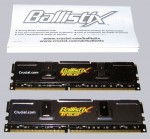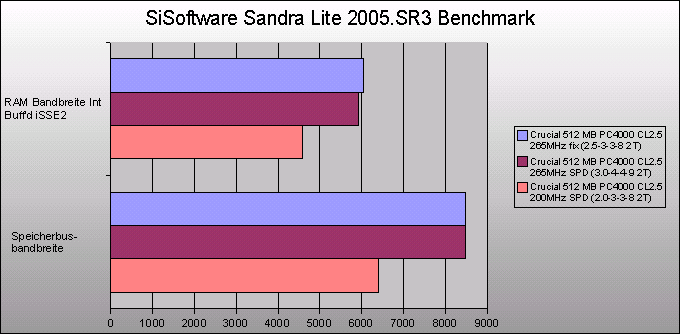
Let us begin with the most important part of the test report, because the optics is of course rather secondary and the possible stable performance is the most important factor. The test results are based on an EPoX 9NPA+ SLI nForce4 Motherboard with an Athlon 64 3000+ CPU with different frequency depending upon reference clock for the different memory benchmarks. Thus the multiplicator adjustment remains on 9x with all frequencies. An adjustment for the CPU in half steps would be too inaccurate to get nearly the same CPU frequency for all tests.
Microsoft Windows XP Professional SP2 is used as operating system. The stability was examined with the software Memtest86
and SiSoft Sandra Lite 2005.SR3 Program is used for all benchmarks, since it offers extensive adjustments and a fast result comparison.
First the maximum possible frequency of the memory module was determined. For this the memory frequency was increased in small step with a fixed memory timing of 2.5-3-3-8 (2T) and default memory voltage, as long as the detailed memory test with Memtest86 was error free. This quite long testing time ensured that this frequency works really stable with these modules.
The highest possible frequency with 2.5-3-3-8 (Tcl Trcd Tras Trp) values was stable with sayful 265 MHz!
With higher voltages or smaller timings it was possible to run still clearly higher frequencies, because the frequency values and timings depends directly from each other. Note: Please don’t try this high timings with conventional PC3200 modules, only increase frequencies in small steps. Otherwise it would end with a beep of the systemspeaker.
This highest possible timing was compared with two further adjustments. On the one hand 265 MHz with SPD values (these are given by the manufacturer in the SPD IC) and on the other hand 200 MHz with SPD values. By the way the memory bus range is no benchmark value, but the value is quite simple to calculate by the frequency and is only useful for the benchmark comparison.
Here’re the Benchmark results:
| Frequency | Timing | RAM Range Int Buff’d iSSE2 | Memory bus range |
| 265 MHz | fix (2.5-3-3-8 2T) | 6033 MB/s | 8480 MB/s |
| 265 MHz | SPD (3.0-4-4-9 2T) | 5932 MB/s | 8480 MB/s |
| 200 MHz | SPD (2.0-3-3-8 2T) | 4580 MB/s | 6400 MB/s |
And here’re again the benchark values as diagram:

Thus it’s a great result, which let us highly overclock a CPU with locked multiplier. Whether one uses rather high timings with a low clock frequency, or better timings with reduced frequency, depends on the respective Motherboard and the used processor (Have a look in our Workshop
to get informations about the locked multiplicator of newer AMD Socket A, AMD Athlon 64 and Intel CPUs). The Crucial Ballistix PC4000 memory modules had wonderful results at all values.

